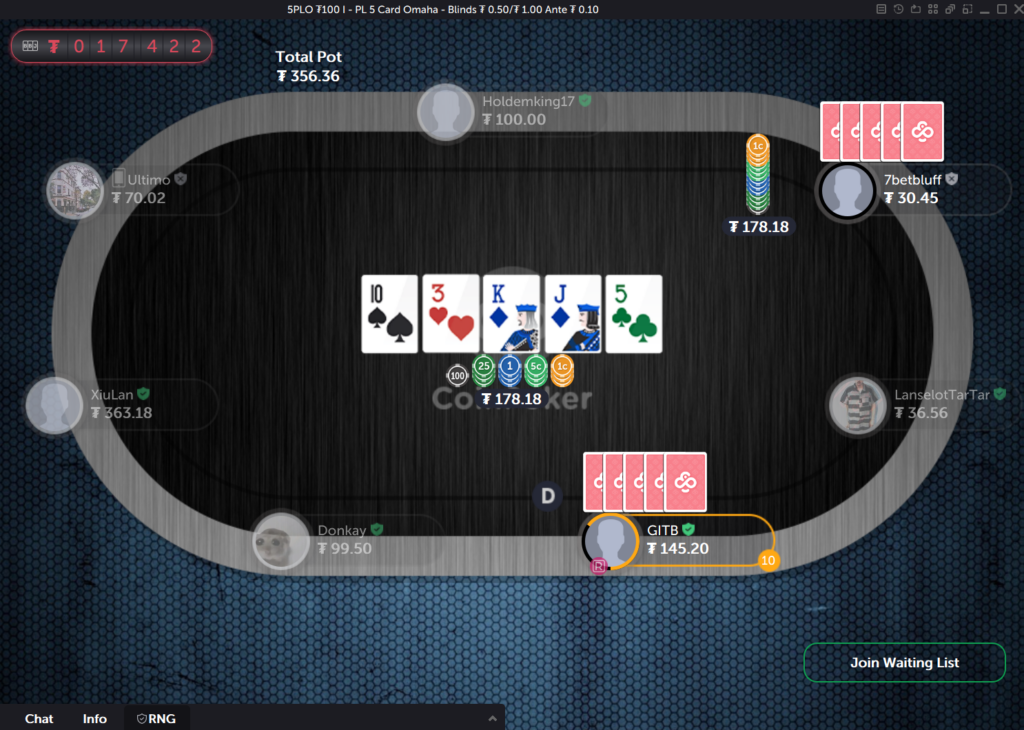Last Updated: 27 May 2025
Aggressive Poker: Unleash Your Inner Shark and Dominate
Even though it goes against our instincts sometimes, getting the hang of aggressive poker will make you a fearsome competitor. In our guide, you'll get acquainted how to apply aggressive poker strategies - the right way.
StrategyPicture this: you’re sitting at a poker table, cards in hand, with your heart racing. You’ve got two options: play it safe or dive into aggressive poker. If you’re serious about taking your game to the next level, it’s time to embrace a more dynamic style. Aggressive poker isn’t just about making bold moves for the sake of it—it’s about playing in a way that forces your opponents to think twice before acting.
What is Aggressive Poker?
Aggressive poker is about taking control of the game and dictating the flow of action. It’s not about passively reacting to your opponents’ moves; it’s about putting them on the defensive. Rather than simply checking or calling, aggressive players constantly make bets and raises, forcing their opponents into tough situations. The goal? To make them fold or force errors as they buckle under pressure.
Aggressive poker is often misunderstood as reckless, but in reality, it requires precision and discipline. It’s about making the right moves at the right time—balancing when to push and when to pull back. Mastering this balance is the key to success in aggressive poker, and once you do, the game is yours to command.

Real-Life Examples of Aggressive Poker
Picture this: You’re at a high-stakes table at CoinPoker, facing off against a skilled opponent. The blinds are 500/1000, and you find yourself holding A♥K♥ on the button. The action folds to you, and you decide to raise it to 2,500. The other player in the hand, sitting in the big blind, 3-bets to 7,500 with a stack of 50,000.
The flop comes J♠8♥3♣, and they continue their aggression with a bet of 10,000. You have a gut feeling they might be trying to push you off your hand with nothing but air. You call, and the turn brings the 2♥. Your aggro opponent doesn’t slow down, firing another bet of 20,000.
This is where the power of a well-timed aggressive move comes into play. Despite facing pressure, you have a draw to the nut flush plus two overcards and decide to turn the tables by check-raising all-in. The “villain” is visibly surprised by your move and goes into the tank before ultimately folding, shipping a sizable pot in your direction.
This hypothetical scenario demonstrates how calculated aggressive play can force even skilled opponents to second-guess their decisions and potentially make costly mistakes.
Why is Aggressive Poker So Powerful?
When you play aggressively, you’re not just relying on the strength of your hand—you’re playing your opponents. By betting and raising consistently, you force them into difficult situations where they might fold even when they’re holding a winning hand. Aggressive poker puts your opponents on edge, causing them to question whether they’re really ahead or walking into a trap.
The key, however, is balance. Push too hard, and you risk overextending yourself, leaving your stack vulnerable. The challenge is knowing when to dial it back and when to go full throttle. Like chess, it’s about positioning yourself for a win through strategic play.
Different Flavors of Aggressive Poker
Aggressive poker comes in two main styles: Loose Aggressive (LAG) and Tight Aggressive (TAG). LAG players are known for playing a wide range of hands, relying heavily on frequent bluffs to keep their opponents on their toes. TAG players, on the other hand, focus on playing fewer hands but raise aggressively when they do. Both styles have their strengths, and knowing when to shift between them is critical for success.
Loose Aggressive (LAG) Style
LAG players are the wildcards of poker, known for their unpredictable and fearless play. They enter pots often, betting as if they have the nuts (the best hand) at all times. This constant pressure makes it difficult for opponents to put them on a specific range of hands, which keeps everyone at the table guessing.
The best LAG players, however, aren’t just reckless—they balance their aggressive bluffs with legitimate hands, mixing things up so opponents never know where they stand. They also excel at reading the table, knowing when to pump the brakes and when to ramp up the heat.
Tight Aggressive (TAG) Style
TAG players are more selective in the hands they choose to play, but when they do, they play them with unrelenting force. They wait for premium hands like pocket pairs or suited connectors, and once they’re in, they push hard, betting big to maximize their potential returns. This selective but aggressive approach allows TAG players to avoid costly mistakes while still applying significant pressure when the odds are in their favor.
TAG players may appear more conservative than their LAG counterparts, but their strategy is built around control. They know when to pull the trigger and when to step back, making their play difficult to counter.
LAG vs. TAG: Which One is the King of Aggressive Poker?
So, which aggressive style reigns supreme? The answer lies in adaptability. LAG players dominate loose, passive games where they can bully weaker opponents into submission. TAG players, on the other hand, excel in tighter, more competitive environments where discipline and patience are paramount.
The secret to success lies in knowing when to switch between the two styles based on table dynamics. The best poker players can fluidly transition from LAG to TAG, keeping their opponents off balance and unable to adjust.
5 Tips to Master Aggressive Poker
Aggressive poker is a powerful strategy that can help you dominate the table, but it’s often misunderstood. Some players believe that being aggressive means betting and raising recklessly, but true mastery lies in controlled aggression. It’s about picking your spots wisely, understanding your opponents, and adapting to the ever-changing dynamics of the game. By following these five tips, you can harness the power of aggression and take your poker game to the next level.
Tip 1: Be Selective with Your Hands
Aggression is most effective when you pick your spots carefully. Focus on strong hands with potential, particularly in late positions where you can see how the action unfolds. By being selective, you can make the most of your aggressive play without putting yourself at unnecessary risk.
Tip 2: Mix Up Your Play
Keep your opponents off-balance by varying your betting patterns. Sometimes you may want to slow-play a strong hand to let your opponents build the pot, while other times, you can make a fast and aggressive move to force them to fold. Unpredictability is a key weapon in aggressive poker.
Tip 3: Control the Pot Size
While aggression is important, managing the pot size is equally crucial. Not every hand needs to result in a massive pot, especially if you’re bluffing. Use small to medium bets to keep the stakes manageable, saving your larger bets for times when you hold a stronger hand.
Tip 4: Target Passive Players
Aggressive play works best against passive players who prefer to fold rather than engage in confrontations. If you spot someone folding often, that’s your cue to ramp up the pressure with well-timed raises, taking advantage of their hesitation.
Tip 5: Watch the Table Dynamics
Poker is as much about reading the room as it is about reading your cards. If you’re playing against tighter, more cautious players, aggression can be a powerful tool for stealing blinds and winning small pots. Against looser players, be more selective with your moves, picking your spots carefully.
Dealing with Aggressive Opponents
When facing aggressive players, patience is your best ally. Don’t get caught up in their constant betting. Instead, wait for a strong hand and trap them by calling down until you know they’re committed, then raise at the perfect moment to take the pot.
Being unpredictable is another effective tactic. Mix up your calls and raises to keep them guessing, and never let them settle into a rhythm. By playing smart and staying calm, you can turn their aggression against them.

Taming the Loose Aggressive (LAG) Beast
LAG players thrive on chaos, making it difficult for others to keep up with their aggressive, unpredictable style. The key to beating them is discipline. Wait for strong hands, and when the time is right, call down their bluffs and force them to commit to losing plays. By staying cool and not falling for their constant aggression, you can come out on top.
Beating Tight Aggressive (TAG) Players at Their Own Game
TAG players are disciplined and selective, but their predictable patterns can be exploited. Watch for signs of weakness, such as checking or hesitating, and use these moments to bluff or apply pressure. Force them to make tough decisions with your well-timed bets, and stay one step ahead by reading their play.
Aggression in Tournaments vs. Cash Games
In tournaments, aggressive play can help you build a strong stack early on, but as the blinds increase, you’ll need to adjust. Cash games allow for more consistent aggression since you can rebuy if necessary, giving you more freedom to push harder. In tournaments, survival becomes critical near the bubble, making selective aggression a better strategy. Knowing when to switch between aggressive and cautious play is essential in cash games and tournaments.
The Pros and Cons of Aggressive Poker
Aggressive poker puts you in control of the table, but comes with risks. The pressure you apply on opponents forces them into tough decisions, often folding hands they would have otherwise won with. But over-aggression can lead to significant losses if you’re caught bluffing. Let’s break down the pros and cons of this strategy.
The Good
- Aggressive poker keeps your opponents on their toes, forcing them to play reactively rather than proactively.
- You’ll win more pots without ever having to show your cards, and the pressure you apply makes it harder for weaker players to stay in the game.
- When you have a strong hand, aggressive betting helps you maximize the value of your wins, building larger pots that you can capitalize on.
The Bad
- On the flip side, being too aggressive can make you predictable. Once your opponents catch on, they may start calling you with stronger hands, and before you know it, you’ve lost a sizable chunk of your stack.
- Over-aggression also increases variance, meaning you could experience big swings in your stack size if you’re not careful.
This is why it’s crucial to know when to pull back and exercise discipline.
Bring Your A-Game to CoinPoker
Ready to test your aggressive poker skills? CoinPoker is the perfect platform for honing your strategy. With fast-paced crypto payments, quick withdrawals, and a vibrant community of players, you’ll have everything you need to dominate the tables.
Sign up now, and see how far your aggressive play can take you.
FAQs
Aggressive poker involves betting and raising frequently to put pressure on opponents.
LAG players are more unpredictable, playing many hands, while TAG players are more selective but aggressive when they do play.
Be patient and wait for strong hands. Let aggressive players overcommit, then raise when you’re confident you’ve got the best hand.
Stay disciplined and wait for premium hands. Call down their bluffs and raise when you have the advantage.
Be aggressive early when stacks are deep but tighten up as the tournament progresses, especially near the bubble.
Explore More
Announcements
Read recent announcements from CoinPoker about new games, ambassadors, and changes to our platform.
8 PostsGuides
The go-to resource for mastering poker with expert tips and strategies. Our guides will elevate your poker skill level.
60 PostsNews
Find the latest poker news and latest CoinPoker Newsletters. Get updates about games, promotions, and crypto news.
92 PostsPromotions
Find the latest coinpoker promotions here. Explore the crypto poker world with the best poker promotions available.
1 Post
















